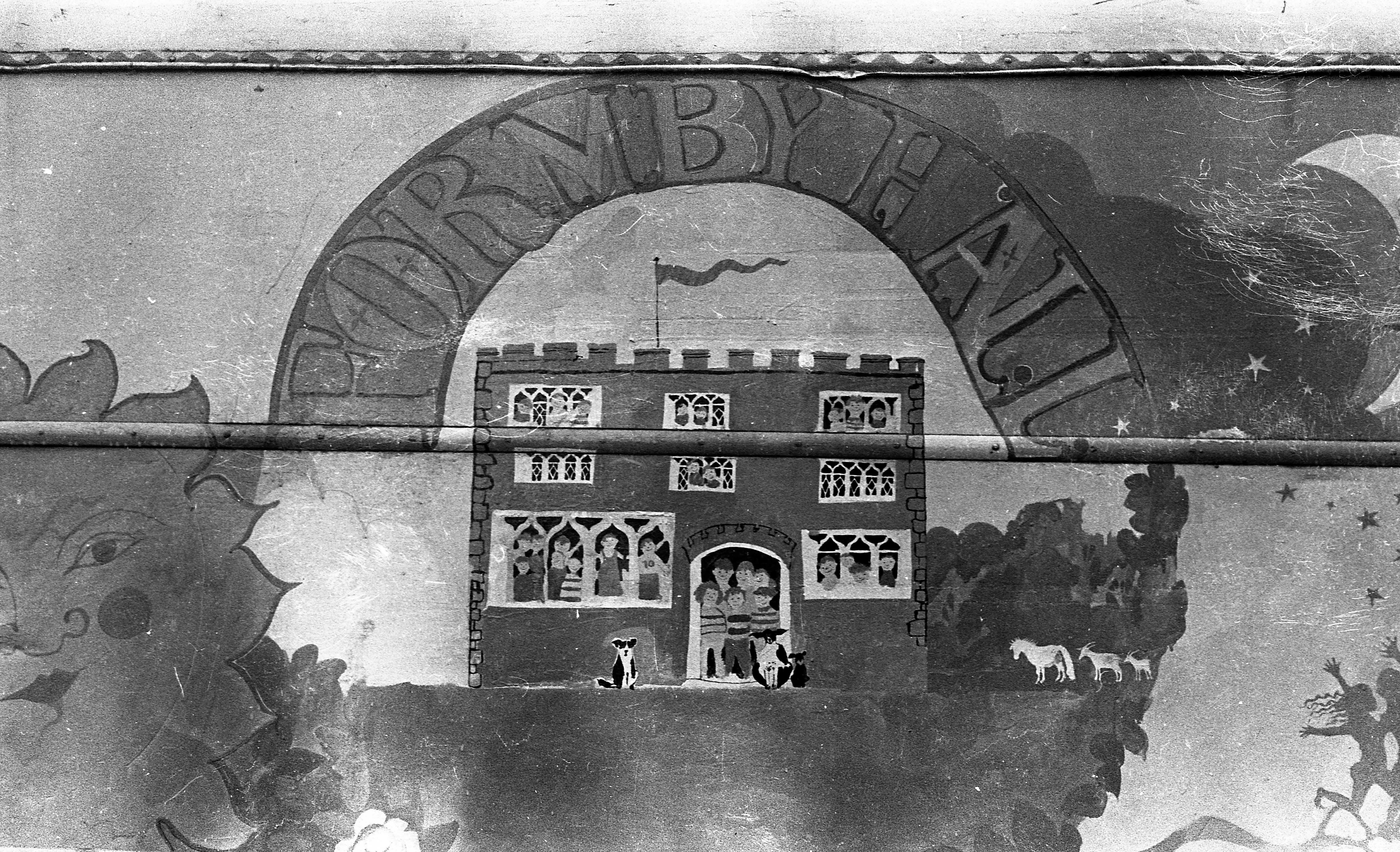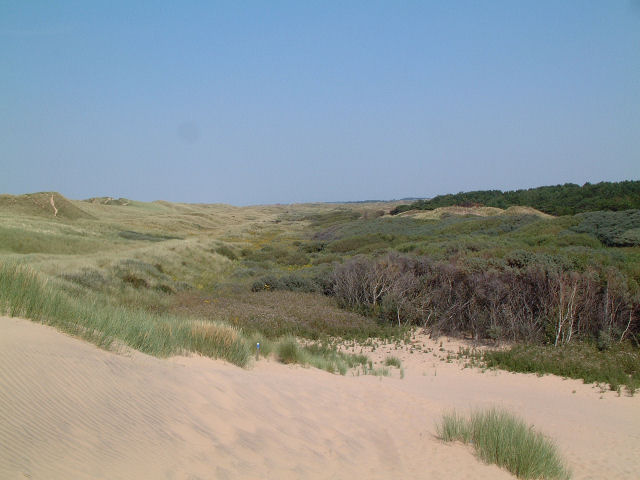|
Formby Hall
Formby Hall is located to the north-east of Formby in the English metropolitan county of Merseyside, in secluded woodland adjoining the Formby Hall Golf and Country Club. The present house, built for William Formby, dates back to 1523 but it is believed that the Formby family has occupied the site since the 12th century. Early years Over the years the hall has seen many owners and occupants. The Formby family lived at Formby Hall in a direct father-to-son line from the year 1110, with just a single break, when a cousin entered the line of succession. Many modifications and additions have been made to the original building. For example, the battlements were added in the 18th century by John Formby who took inspiration from the Gothic-style architecture of Horace Walpole's home at Twickenham. In 1896, the hall was modernised by Colonel John Formby who added the West Wing drawing room. 20th century During World War II, the hall was continuously occupied by army personnel, with u ... [...More Info...] [...Related Items...] OR: [Wikipedia] [Google] [Baidu] |
Formby Hall Logo 1977
Formby is a town and civil parish in the Metropolitan Borough of Sefton, Merseyside, England, which had a population of 22,419 at the 2011 Census. Historically in Lancashire, three manors are recorded in the Domesday Book of 1086 under "Fornebei", Halsall, Walton and Poynton. Cockle raking and shrimp fishing lasted into the 19th century. By 1872, the township and sub-district was made up of two chapelries ( St Peter's and St Luke's), Birkdale township, the hamlets of Ainsdale and Raven-Meols and Altcar parish. The Section dedicated to Formby. Formby was built on the plain adjoining the Irish Sea coast a few miles north of the Crosby channel. A commuter town for Liverpool, Formby is also a tourist destination with day trippers attracted to its beaches, sand dunes and wildlife, particularly the endangered red squirrel and natterjack toad. The area is conserved by the National Trust, and designated a Site of Special Scientific Interest. History Erosion of sand on ... [...More Info...] [...Related Items...] OR: [Wikipedia] [Google] [Baidu] |
Trees At Formby Hall In Late Evening Light
In botany, a tree is a perennial plant with an elongated stem, or trunk, usually supporting branches and leaves. In some usages, the definition of a tree may be narrower, including only woody plants with secondary growth, plants that are usable as lumber or plants above a specified height. In wider definitions, the taller palms, tree ferns, bananas, and bamboos are also trees. Trees are not a taxonomic group but include a variety of plant species that have independently evolved a trunk and branches as a way to tower above other plants to compete for sunlight. The majority of tree species are angiosperms or hardwoods; of the rest, many are gymnosperms or softwoods. Trees tend to be long-lived, some reaching several thousand years old. Trees have been in existence for 370 million years. It is estimated that there are some three trillion mature trees in the world. A tree typically has many secondary branches supported clear of the ground by the trunk. This trunk typic ... [...More Info...] [...Related Items...] OR: [Wikipedia] [Google] [Baidu] |
Formby
Formby is a town and civil parish in the Metropolitan Borough of Sefton, Merseyside, England, which had a population of 22,419 at the 2011 Census. Historically in Lancashire, three manors are recorded in the Domesday Book of 1086 under "Fornebei", Halsall, Walton and Poynton. Cockle raking and shrimp fishing lasted into the 19th century. By 1872, the township and sub-district was made up of two chapelries ( St Peter's and St Luke's), Birkdale township, the hamlets of Ainsdale and Raven-Meols and Altcar parish. The Section dedicated to Formby. Formby was built on the plain adjoining the Irish Sea coast a few miles north of the Crosby channel. A commuter town for Liverpool, Formby is also a tourist destination with day trippers attracted to its beaches, sand dunes and wildlife, particularly the endangered red squirrel and natterjack toad. The area is conserved by the National Trust, and designated a Site of Special Scientific Interest. History Erosion of sand on the b ... [...More Info...] [...Related Items...] OR: [Wikipedia] [Google] [Baidu] |
England
England is a country that is part of the United Kingdom. It shares land borders with Wales to its west and Scotland to its north. The Irish Sea lies northwest and the Celtic Sea to the southwest. It is separated from continental Europe by the North Sea to the east and the English Channel to the south. The country covers five-eighths of the island of Great Britain, which lies in the North Atlantic, and includes over 100 smaller islands, such as the Isles of Scilly and the Isle of Wight. The area now called England was first inhabited by modern humans during the Upper Paleolithic period, but takes its name from the Angles, a Germanic tribe deriving its name from the Anglia peninsula, who settled during the 5th and 6th centuries. England became a unified state in the 10th century and has had a significant cultural and legal impact on the wider world since the Age of Discovery, which began during the 15th century. The English language, the Anglican Church, and Engli ... [...More Info...] [...Related Items...] OR: [Wikipedia] [Google] [Baidu] |
Merseyside
Merseyside ( ) is a metropolitan county, metropolitan and ceremonial counties of England, ceremonial county in North West England, with a population of List of ceremonial counties of England, 1.38 million. It encompasses both banks of the Mersey Estuary and comprises five metropolitan boroughs: Metropolitan Borough of Knowsley, Knowsley, Metropolitan Borough of St Helens, St Helens, Metropolitan Borough of Sefton, Sefton, Metropolitan Borough of Wirral, Wirral and the city of Liverpool. Merseyside, which was created on 1 April 1974 as a result of the Local Government Act 1972, takes its name from the River Mersey and sits within the historic counties of Lancashire and Cheshire. Merseyside spans of land. It borders the ceremonial counties of Lancashire (to the north-east), Greater Manchester (to the east), Cheshire (to the south and south-east) and the Irish Sea to the west. North Wales is across the Dee Estuary. There is a mix of high density urban areas, suburbs, semi-rur ... [...More Info...] [...Related Items...] OR: [Wikipedia] [Google] [Baidu] |
Gothic Revival Architecture
Gothic Revival (also referred to as Victorian Gothic, neo-Gothic, or Gothick) is an architectural movement that began in the late 1740s in England. The movement gained momentum and expanded in the first half of the 19th century, as increasingly serious and learned admirers of the neo-Gothic styles sought to revive medieval Gothic architecture, intending to complement or even supersede the neoclassical styles prevalent at the time. Gothic Revival draws upon features of medieval examples, including decorative patterns, finials, lancet windows, and hood moulds. By the middle of the 19th century, Gothic had become the preeminent architectural style in the Western world, only to fall out of fashion in the 1880s and early 1890s. The Gothic Revival movement's roots are intertwined with philosophical movements associated with Catholicism and a re-awakening of high church or Anglo-Catholic belief concerned by the growth of religious nonconformism. Ultimately, the "Anglo-Catholicism" t ... [...More Info...] [...Related Items...] OR: [Wikipedia] [Google] [Baidu] |
Horace Walpole
Horatio Walpole (), 4th Earl of Orford (24 September 1717 – 2 March 1797), better known as Horace Walpole, was an English writer, art historian, man of letters, antiquarian, and Whigs (British political party), Whig politician. He had Strawberry Hill House built in Twickenham, southwest London, reviving the Gothic Revival, Gothic style some decades before his Victorian era, Victorian successors. His literary reputation rests on the first Gothic fiction, Gothic novel, ''The Castle of Otranto'' (1764), and his ''Letters'', which are of significant social and political interest. They have been published by Yale University Press in 48 volumes. In 2017, a volume of Walpole's selected letters was published. The youngest son of the first British Prime Minister, Sir Robert Walpole, 1st Earl of Orford, he became the 4th and last Earl of Orford of the second creation on his nephew's death in 1791. Early life: 1717–1739 Walpole was born in London, the youngest son of Prime Minister ... [...More Info...] [...Related Items...] OR: [Wikipedia] [Google] [Baidu] |






_-_Jonathan_Richardson_the_Elder_(Casa-Museu_Medeiros_e_Almeida).png)